Effects of the Geomagnetic Superstorms of 10–11 May 2024 and 7–11 October 2024 on the Ionosphere and Plasmasphere
Abstract
1. Introduction: Strongest Storms of Solar Cycle 25
- Is it possible to know exactly how deep the ionospheric depletion will be, and how long it will last?
- How does the atmospheric response to geomagnetic storms change depending on the latitude and longitude?
- How is the atmospheric ionization modified as a function of the altitude, including above the ionospheric layers in the plasmasphere?
- Including the plasmasphere that is directly coupled to the ionosphere and provides magnetospheric effects in three dimensions;
- Providing a comparison between measurements of different instruments (VTEC, ionosondes, and plasmapause), helping to differentiate the effects at different altitudes;
- Analyzing these measurements at different places all around the world (Europe, North Africa, America, and Asia) to differentiate the effects at different latitudes and longitudes;
- Comparing the Mother’s Day event with the second strongest superstorm of this solar cycle, the event of October 2024, for which the present study is a pioneer to our knowledge. This allows us to determine how the intensity of the geomagnetic storms modifies the atmospheric ionization.
- The Mother’s Day storm on 10–11 May 2024.
- The successive storms on 8–11 October 2024.
2. Observation Methods
2.1. Solar Wind and Geomagnetic Indices
2.2. Vertical Total Electron Content VTEC
- (a)
- In the northern part of Europe (61° N, 5° E);
- (b)
- Above Brussels, in mid-latitude Europe (50.5° N, 4.5° E);
- (c)
- In North Africa (36° N, 5° E).
2.3. Ionosonde Observations
2.4. Plasmasphere Model and Data
3. Mother’s Day Storm: 10–11 May 2024
3.1. Observed Solar Wind and Geomagnetic Indices
3.2. Ionospheric Vertical Total Electron Content
3.3. Ionosonde Observations
3.4. Plasmasphere
4. Comparison with Event of 10 to 11 October 2024
4.1. Solar Wind and Geomagnetic Activity Indices
4.2. Ionospheric VTEC
4.3. Ionosonde Observations
4.4. Plasmasphere
5. Discussion and Conclusions
- While the ionization increases during the main phase of the storms, the density of electrons decreases for at least one day after the storms.
- The VTEC depletion is not only due to a decrease in the ionization in the F2 layer but also to a closer plasmapause, as shown using Swarm plasmapause observations. This confirms that sharp electron density depletion is associated with plasmasphere erosion [24]. This was also observed in the studies of previous geomagnetic storms. For instance, it was found that the plasmasphere can lose 40% or more of its total mass during massive erosions [47]. The relative contribution of the plasmasphere to the nighttime (i.e., locally) total electron content (TEC) can easily go beyond 80% during severely disturbed periods [48]. The plasmasphere is often overlooked despite the direct interaction between the ionosphere–plasmasphere system.
- The F2 layer refills very suddenly after the Mother’s Day event, which is very unusual. Measurements using different instruments (ionosondes, GNSS) at different latitudes and longitudes on different continents indicate that the sudden refilling occurs at the same time in the European and American sectors, despite the local time difference. The refilling occurred earlier at the lower latitudes.
- The comparison of two superstorms with different intensities allowed us to determine how different mechanisms can take place depending on the events. Indeed, clear differences could be observed in the response of the ionospheric layers to both storms. The storms were similar in strengths and in the local time of the onset. However, the background conditions of the ionosphere in May and October are very different, at least in the lower ionosphere. The F1 peak is more pronounced in May than in October, but the F2 peak is more compact in October, with a peak density somewhat higher than in May. These differences in the structure of the ionospheric layers lead to the effects of the storm being visible for a longer time for the May event, with the F2 layer only becoming visible again during the second day after the storm.
- G-condition (i.e., when the F2 layer is not detected because the density is higher in the F1 layer than in F2) is observed for the entirety of 11 May, while it is almost absent in October 2024. G-condition is found to always be more severe and longer lasting at higher latitudes. This is largely due to the different climatological background conditions, because the storms happened in different seasons. This is consistent with the observations made in [38], where storms from March and April 2023 were discussed. Such seasonal differences are smaller at higher altitudes.
- The spectacular loss of F2 layer ionization observed during both storms can be due to an increase in the recombination rates, associated with a higher temperature and density caused by the injection of particles, in combination with the outflow of ionization. The analysis of Swarm data during the May event [10] shows an equatorward displacement of the mid-latitude ionospheric trough, confirming the importance of high-altitude influence.
Author Contributions
Funding
Institutional Review Board Statement
Data Availability Statement
Conflicts of Interest
References
- Pierrard, V.; Winant, A.; Botek, E.; Péters de Bonhome, M. The Mother’s Day solar storm of 11 May 2024 and its effect on Earth’s radiation belts. Universe 2024, 10, 391. [Google Scholar] [CrossRef]
- Spogli, L.; Alberti, T.; Bagiacchi, P.; Cafarella, L.; Cesaroni, C.; Cianchini, G.; Coco, I.; Di Mauro, D.; Ghidoni, R.; Giannattasio, F.; et al. The effects of the May 2024 Mother’s Day superstorm over the Mediterranean sector: From data to public communication. Ann. Geophys. 2024, 67, 218. [Google Scholar] [CrossRef]
- Gonzalez-Esparza, J.A.; Sanchez-Garcia, E.; Sergeeva, M.; Corona-Romero, P.; Gonzalez-Mendez, L.X.; Valdes-Galicia, J.F.; Aguilar-Rodriguez, E.; Rodriguez-Martinez, M.; Ramirez-Pacheco, C.; Castellanos, C.I.; et al. The Mother’s Day geomagnetic storm on 10 May 2024: Aurora observations and low latitude space weather effects in Mexico. Space Weather 2024, 22, e2024SW004111. [Google Scholar] [CrossRef]
- Karan, D.K.; Martinis, C.R.; Daniell, R.; Eastes, R.W.; Wang, W.; McClintock, W.E.; Michell, R.G.; England, S.L. GOLD observations of the merging of the Southern Crest of the equatorial ionization anomaly and aurora during the 10 and 11 May 2024 Mother’s Day super geomagnetic storm. Geophys. Res. Lett. 2024, 51, e2024GL110632. [Google Scholar] [CrossRef]
- Singh, R.; Scipión, D.E.; Kuyeng, K.; Condor, P.; De La Jara, C.; Velasquez, J.P.; Flores, R.; Ivan, E.; Souza, J.R.; Migliozzi, M. Ionospheric Disturbances Observed Over the Peruvian Sector During the Mother’s Day Storm (G5-Level) on 10–12 May 2024. J. Geophys. Res. Space Phys. 2024, 129, 12. [Google Scholar] [CrossRef]
- Huang, F.; Lei, J.; Zhang, S.-R.; Wang, Y.; Li, Z.; Zhong, J.; Yan, R.; Aa, E.; Zhima, Z.; Luan, X. Peculiar Nighttime Ionospheric Enhancements over the Asian Sector During the May 2024 Superstorm. J. Geophys. Res. Space Phys. 2024, 129, 11. [Google Scholar] [CrossRef]
- Zhang, R.; Liu, L.; Yang, Y.; Li, W.; Zhao, X.; Yoshikawa, A.; Tariq, M.A.; Chen, Y.; Le, H. Ionosphere Responses Over Asian-Australian and American Sectors to the 10–12 May 2024 Superstorm. J. Geophys. Res. Space Res. 2024, 129, e2024JA033071. [Google Scholar] [CrossRef]
- Aa, E.; Zhang, S.-R.; Lei, J.; Huang, F.; Erickson, P.J.; Coster, A.J.; Luo, B. Significant midlatitude plasma density peaks and dual-hemisphere SED during the 10–11 May 2024 super geomagnetic storm. J. Geophys. Res. Space Phys. 2024, 129, e2024JA033360. [Google Scholar] [CrossRef]
- Carmo, C.S.; Dai, L.; Wrasse, C.M.; Barros, D.; Takahashi, H.; Figueiredo, C.A.O.B.; Wang, C.; Li, H.; Liu, Z. Ionospheric response to the extreme 2024 Mother’s Day geomagnetic storm over the Latin American sector. Space Weather 2024, 22, e2024SW004054. [Google Scholar] [CrossRef]
- Paul, K.S.; Haralambous, H.; Moses, M.; Oikonomou, C.; Potirakis, S.M.; Bergeot, N.; Chevalier, J.-M. Investigation of the Ionospheric Response on Mother’s Day 2024 Geomagnetic Superstorm over the European Sector. Atmosphere 2025, 16, 180. [Google Scholar] [CrossRef]
- Vichare, G.; Bagiya, M.S. Manifestations of strong IMF-by on the equatorial ionospheric electrodynamics during 10 May 2024 geomagnetic storm. Geophys. Res. Lett. 2024, 51, e2024GL112569. [Google Scholar] [CrossRef]
- Rout, D.; Kumar, A.; Singh, R.; Patra, S.; Karan, D.K.; Chakraborty, S.; Scipion, D.; Chakrabarty, D.; Riccobono, J. Evidence of unusually strong equatorial ionization anomaly at three local time sectors during the Mother’s Day geomagnetic storm on 10–11 May 2024. Geophys. Res. Lett. 2024, 52, e2024GL111269. [Google Scholar] [CrossRef]
- Themens, D.R.; Elvidge, S.; McCaffrey, A.; Jayachandran, P.T.; Coster, A.; Varney, R.H.; Galkin, I.; Goodwin, L.V.; Watson, C.; Maguire, S.; et al. The high latitude ionospheric response to the major May 2024 geomagnetic storm: A synoptic view. Geophys. Res. Lett. 2024, 51, e2024GL111677. [Google Scholar] [CrossRef]
- Foster, J.C.; Erickson, P.J.; Nishimura, Y.; Zhang, S.R.; Bush, D.C.; Coster, A.J.; Meade, P.E.; Franco-Diaz, E. Imaging the May 2024 extreme aurora with ionospheric total electron content. Geophys. Res. Lett. 2024, 51, e2024GL111981. [Google Scholar] [CrossRef]
- Resende, L.C.A.; Zhu, Y.; Santos, A.M.; Chagas, R.A.J.; Denardini, C.M.; Arras, C.; Da Silva, L.A.; Nogueira, P.A.B.; Chen, S.S.; Andrioli, V.F.; et al. Nocturnal Sporadic Cusp-Type Layer (Esc) Resulting from Anomalous Excess Ionization over the SAMA Region During the Extreme Magnetic Storm on 11 May 2024. J. Geophys. Res. Space Phys. 2024, 129, 11. [Google Scholar] [CrossRef]
- Kumar Ranjan, A.; Nailwal, D.; Sunil Krishna, M.V.; Kumar, A.; Sarkhel, S. Evidence of potential thermospheric overcooling during the May 2024 geomagnetic superstorm. J. Geophys. Res. Space Phys. 2024, 129, e2024JA033148. [Google Scholar] [CrossRef]
- Liu, X.; Xu, J.; Yue, J.; Wang, W.; Moro, J. Mesosphere and lower thermosphere temperature responses to the May 2024 Mother’s Day storm. Geophys. Res. Lett. 2025, 52, e2024GL112179. [Google Scholar] [CrossRef]
- Evans, J.S.; Correira, J.; Lumpe, J.D.; Eastes, R.W.; Gan, Q.; Laskar, F.I.; Aryal, S.; Wang, W.; Burns, A.G.; Beland, S.; et al. GOLD observations of the thermospheric response to the 10–12 May2024 Gannon superstorm. Geophys. Res. Lett. 2024, 51, e2024GL110506. [Google Scholar] [CrossRef]
- Ram, S.T.; Veenadhari, B.; Dimri, A.P.; Bulusu, J.; Bagiya, M.; Gurubaran, S.; Parihar, N.; Remya, B.; Seemala, G.; Singh, R.; et al. Super-intense geomagnetic storm on 10–11 May 2024: Possible mechanisms and impacts. Space Weather 2024, 22, e2024SW004126. [Google Scholar] [CrossRef]
- Pierrard, V.; Botek, E.; Darrouzet, F. Improving Predictions of the 3D Dynamic Model of the Plasmasphere. Front. Astron. Space Sci. 2021, 8, 681401. [Google Scholar] [CrossRef]
- Bruyninx, C.; Legrand, J.; Fabian, A.; Pottiaux, E. GNSS metadata and data validation in the EUREF Permanent Network. GPS Solut. 2019, 23, 106. [Google Scholar] [CrossRef]
- Bergeot, N.; Chevalier, J.-M.; Bruyninx, C.; Pottiaux, E.; Aerts, W.; Baire, Q.; Legrand, J.; Defraigne, P.; Huang, W. Near real-time ionospheric monitoring over Europe at the Royal Observatory of Belgium using GNSS data. J. Space Weather Space Clim. 2014, 4, A31. [Google Scholar] [CrossRef]
- Reinisch, B.W.; Galkin, I.A. Global ionospheric radio observatory (GIRO). Earth Planets Space 2011, 63, 377–381. [Google Scholar] [CrossRef]
- Pierrard, V.; Stegen, K. A three-dimensional dynamic kinetic model of the plasmasphere. J. Geophys. Res. 2008, 113, A10209. [Google Scholar] [CrossRef]
- Pierrard, V.; Voiculescu, M. The 3D model of the plasmasphere coupled to the ionosphere. Geophys. Res. Lett. 2011, 38, L12104. [Google Scholar] [CrossRef]
- Botek, E.; Pierrard, V.; Darrouzet, F. Assessment of the Earth’s cold plasmatrough modeling by using Van Allen Probes/EMFISIS and Arase/PWE electron density data. J. Geophys. Res. Space Res. 2021, 126, e2021JA029737. [Google Scholar] [CrossRef]
- Pierrard, V.; Cabrera, J. Comparisons between EUV/IMAGE observations and numerical simulations of the plasmapause formation. Ann. Geophys. 2005, 23, 2635–2646. [Google Scholar] [CrossRef]
- Verbanac, G.; Pierrard, V.; Bandic, M.; Darrouzet, F.; Rauch, J.-L.; Décréau, P. Relationship between plasmapause, solar wind and geomagnetic activity between 2007 and 2011 using Cluster data. Ann. Geophys. 2015, 33, 1271–1283. [Google Scholar] [CrossRef]
- Bandic, M.; Verbanac, G.; Pierrard, V.; Cho, J. Evidence of MLT propagation of the plasmapause inferred from THEMIS data. J. Atmosph. Sol.-Terr. Phys. 2017, 161, 55–63. [Google Scholar] [CrossRef]
- Belehaki, A.; Häggström, I.; Kiss, T.; Galkin, I.; Tjulin, A.; Mihalikova, M.; Pierantoni, G.; Chen, Y.; Sipos, G.; Bruinsma, S.; et al. Integrating plasmasphere, ionosphere and thermosphere observations and models into a standardised open access research environment: The PITHIA-NRF international project. Adv. Space Res. 2024, 75, 3082–3114. [Google Scholar] [CrossRef]
- Heilig, B.; Stolle, C.; Kervalishvili, G.; Rauberg, J.; Miyoshi, Y.; Tsuchiya, F.; Kumamoto, A.; Kasahara, Y.; Shoji, M.; Nakamura, S.; et al. Relation of the plasmapause to the midlatitude ionospheric trough, the sub-auroral temperature enhancement and the distribution of small-scale field aligned currents as observed in the magnetosphere by THEMIS, RBSP, and Arase, and in the topside ionosphere by Swarm. J. Geophys. Res. Space Phys. 2022, 127, e2021JA029646. [Google Scholar] [CrossRef]
- Olsen, N.; Friis-Christensen, E.; Floberghagen, R. The Swarm Satellite Constellation Application and Research Facility (SCARF) and Swarm data products. Earth Planet Space 2013, 65, 1189–1200. [Google Scholar] [CrossRef]
- Knudsen, D.J.; Burchill, J.K.; Buchert, S.C.; Eriksson, A.I.; Gill, R.; Wahlund, J.-E.; Åhlen, L.; Smith, M.; Moffat, B. Thermal ion imagers and Langmuir probes in the Swarm electric field instruments. J. Geophys. Res. Space Phys. 2017, 122, 2655–2673. [Google Scholar] [CrossRef]
- Heilig, B.; Lühr, H. Quantifying the relationship between the plasmapause and the inner boundary of small-scale field-aligned currents, as deduced from Swarm observations. Ann. Geophys. 2018, 36, 595–607. [Google Scholar] [CrossRef]
- Pierrard, V. Effects of the Sun on the Space Environment of the Earth; Presses Universitaires de Louvain: Louvain-la-Neuve, Belgium, 2024; 208p, ISBN 978-2-39061-442-5. Available online: https://i6doc.com/en/book/?gcoi=28001100628290 (accessed on 2 May 2024).
- Mendillo, M. Storms in the ionosphere: Patterns and processes for total electron content. Rev. Geophys. 2006, 44, RG4001. [Google Scholar] [CrossRef]
- Bergeot, N.; Tsagouri, I.; Bruyninx, C.; Legrand, J.; Chevalier, J.-M.; Defraigne, P.; Baire, Q.; Pottiaux, E. The influence of space weather on ionospheric total electron content during the 23rd solar cycle. J. Space Weather Space Clim. 2013, 3, A25. [Google Scholar] [CrossRef]
- Mošna, Z.; Barta, V.; Berényi, K.A.; Mielich, J.; Verhulst, T.; Kouba, D.; Urbář, J.; Chum, J.; Knížová, P.K.; Marew, H.; et al. The March and April 2023 ionospheric storms over Europe. Front. Astron. Space Sci. 2024, 11, 1462160. [Google Scholar] [CrossRef]
- Tsagouri, I.; Belehaki, A.; Koutroumbas, K.; Tziotziou, K.; Herekakis, T. Identification of Large-Scale Travelling Ionospheric Disturbances (LSTIDs) Based on Digisonde Observations. Atmosphere 2023, 14, 331. [Google Scholar] [CrossRef]
- Kauristie, K.; Andries, J.; Beck, P.; Berdermann, J.; Berghmans, D.; Cesaroni, C.; De Donder, E.; de Patoul, J.; Dierckxsens, M.; Doornbos, E.; et al. Space Weather Services for Civil Aviation—Challenges and Solutions. Remote Sens. 2021, 13, 3685. [Google Scholar] [CrossRef]
- Pierrard, V.; Cabrera, J. Dynamical simulations of plasmapause deformations. Space Sci. Rev. 2006, 122, 119–126. [Google Scholar] [CrossRef]
- Darrouzet, F.; De Keyser, J.; Pierrard, V. (Eds.) The Earth’s Plasmasphere: Cluster and IMAGE–A Modern Perspective; Springer: New York, NY, USA, 2009; 296p. [Google Scholar]
- Ripoll, J.-F.; Pierrard, V.; Cunningham, G.S.; Chu, X.; Sorathia, K.A.; Hartley, D.P.; Thaller, S.A.; Merkin, V.G.; Delzanno, G.L.; De Pascuale, S.; et al. Modeling of the cold electron plasma density for radiation belt physics. Front. Astron. Space Sci. 2023, 10, 1096595. [Google Scholar] [CrossRef]
- Ripoll, J.-F.; Thaller, S.; Hartley, D.; Malaspina, D.; Kurth, W.; Cunningham, G.S.; Pierrard, V.; Wygant, J. Statistics and models of the electron plasma density from the Van Allen Probes. J. Geophys. Res. Space Phys. 2024, 129, e2024JA032528. [Google Scholar] [CrossRef]
- Pierrard, V.; Botek, E.; Ripoll, J.-F.; Thaller, S.A.; Moldwin, M.B.; Ruohoniemi, M.; Reeves, G. Links of the plasmapause with other boundary layers of the magnetosphere: Ionospheric convection, radiation belts boundaries, auroral oval. Front. Astron. Space Sci. 2021, 8, 728531. [Google Scholar] [CrossRef]
- Mcllwain, C.E. A Kp Dependent Equatorial Electric Field Model: The Physics of Thermal Plasma in the Magnetosphere. Adv. Space Res. 1986, 6, 187–197. [Google Scholar] [CrossRef]
- Gallagher, D.L.; Comfort, R.H.; Katus, R.M.; Sandel, B.R.; Fung, S.F.; Adrian, M.L. The breathing plasmasphere: Erosion and refilling. J. Geophys. Res. Space Phys. 2021, 126, e2020JA028727. [Google Scholar] [CrossRef]
- Klimenko, M.V.; Klimenko, V.V.; Zakharenkova, I.E.; Cherniak, I.V. The global morphology of the plasmaspheric electron content during northern winter 2009 based on GPS/COSMIC observation and GSM TIP model results. Adv. Space Res. 2015, 55, 2077–2085. [Google Scholar] [CrossRef]

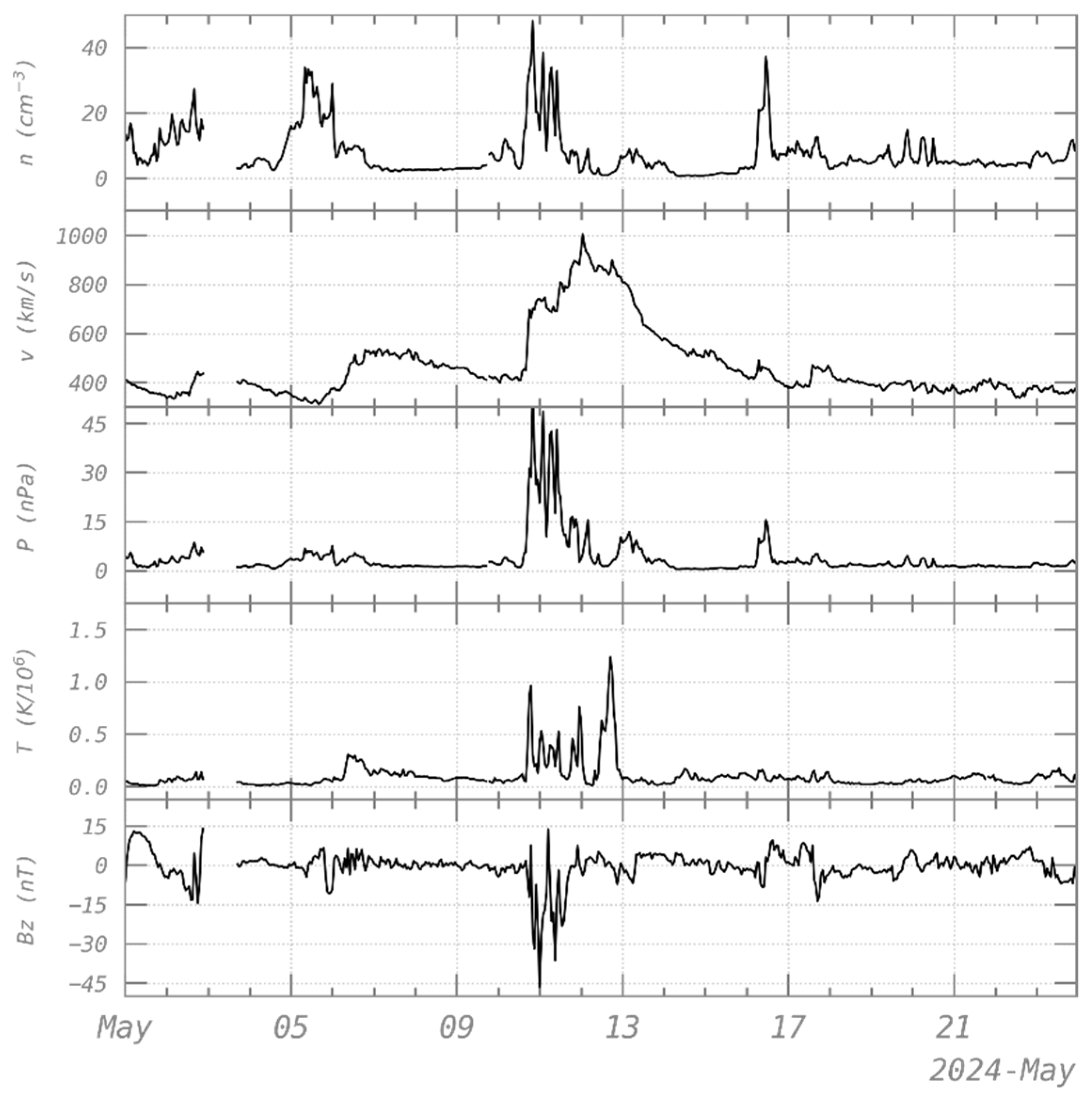
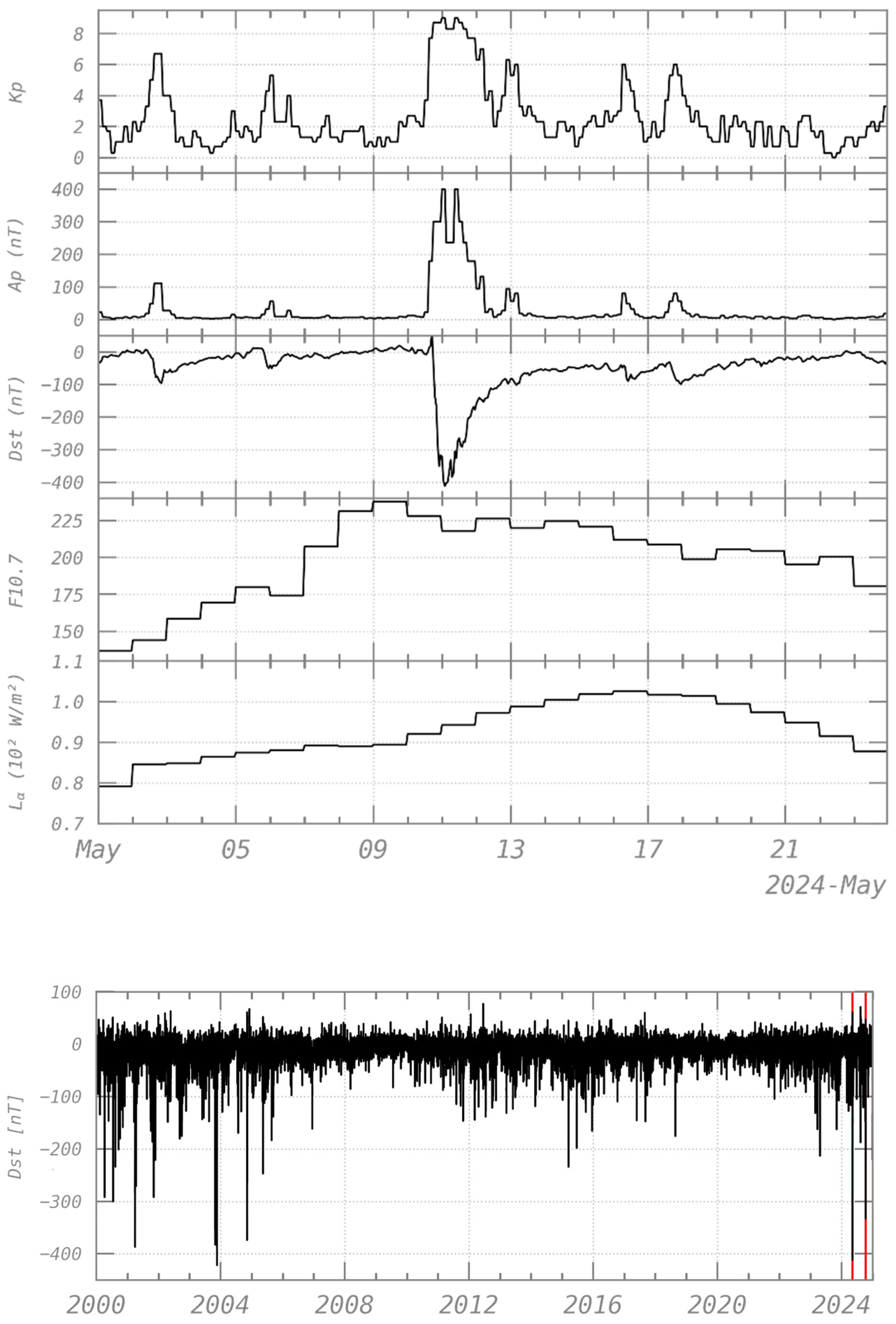
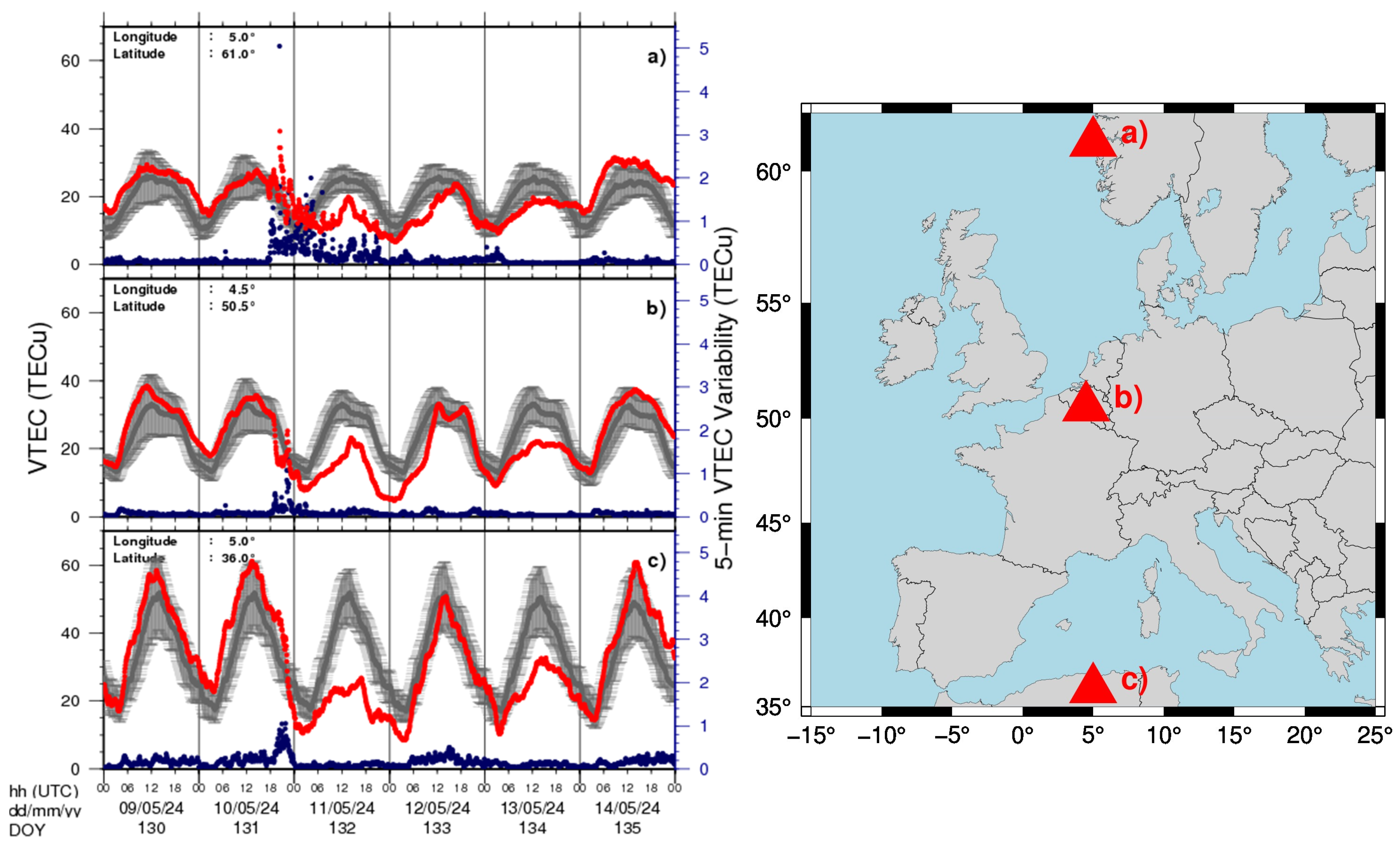
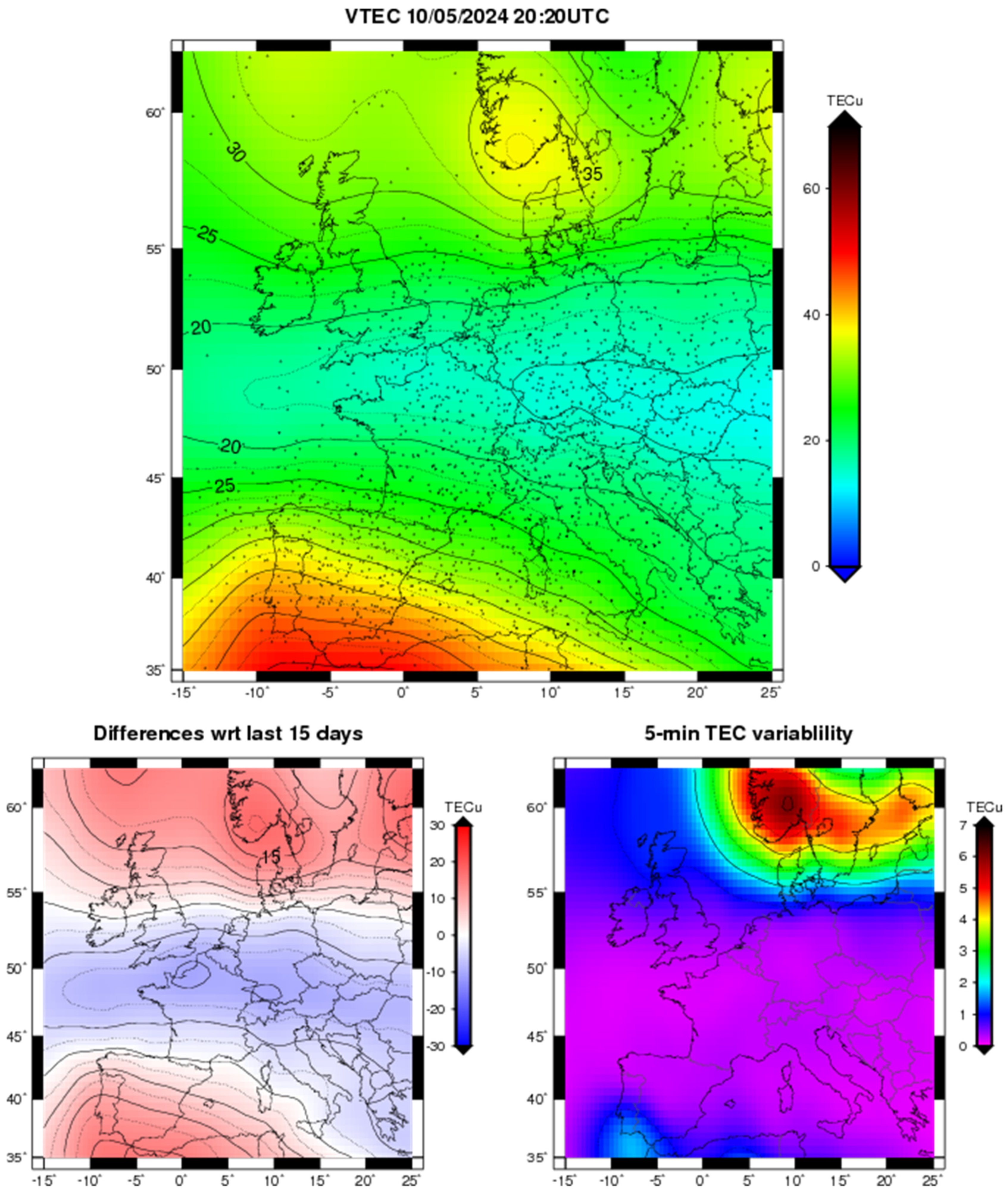
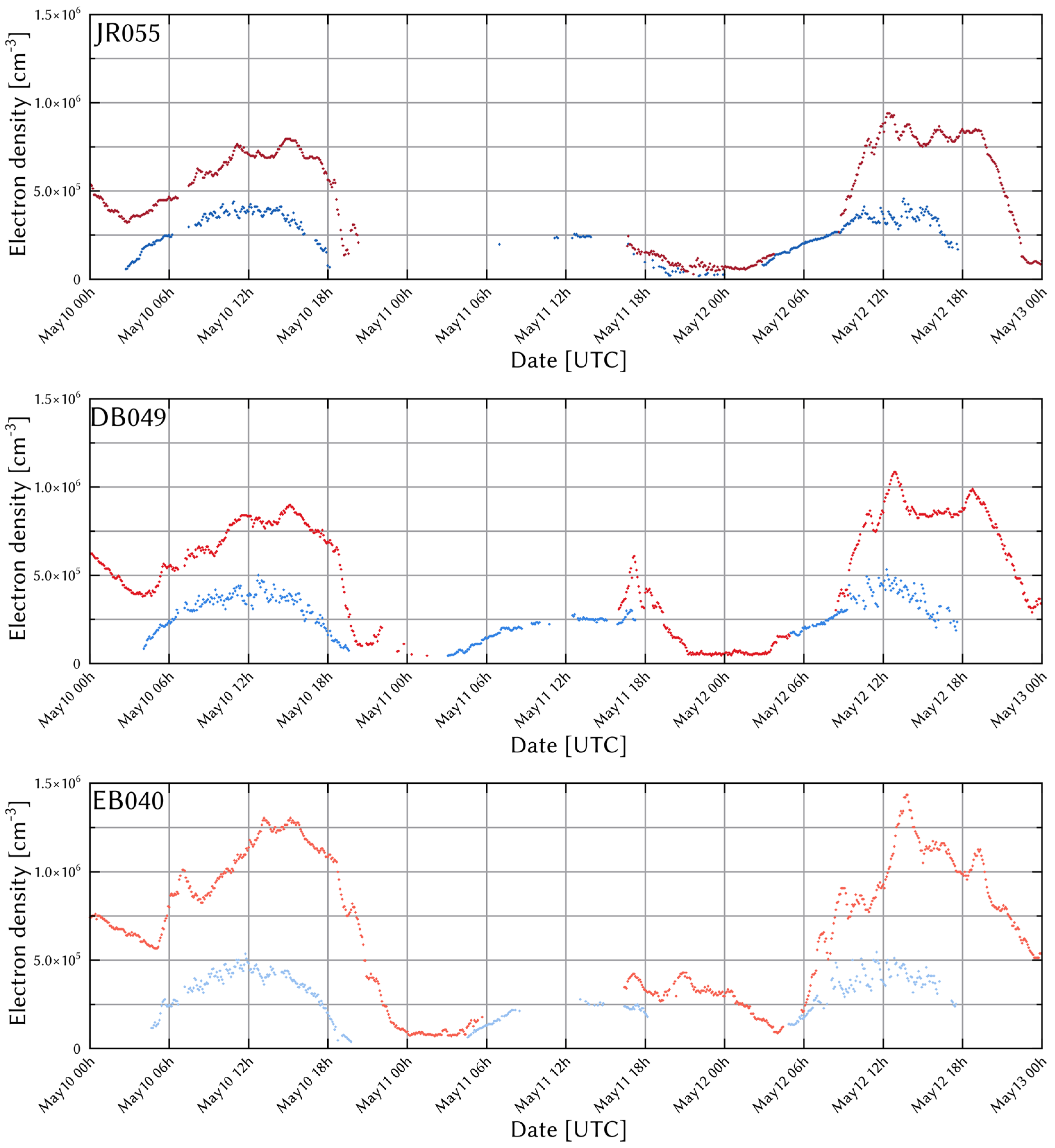
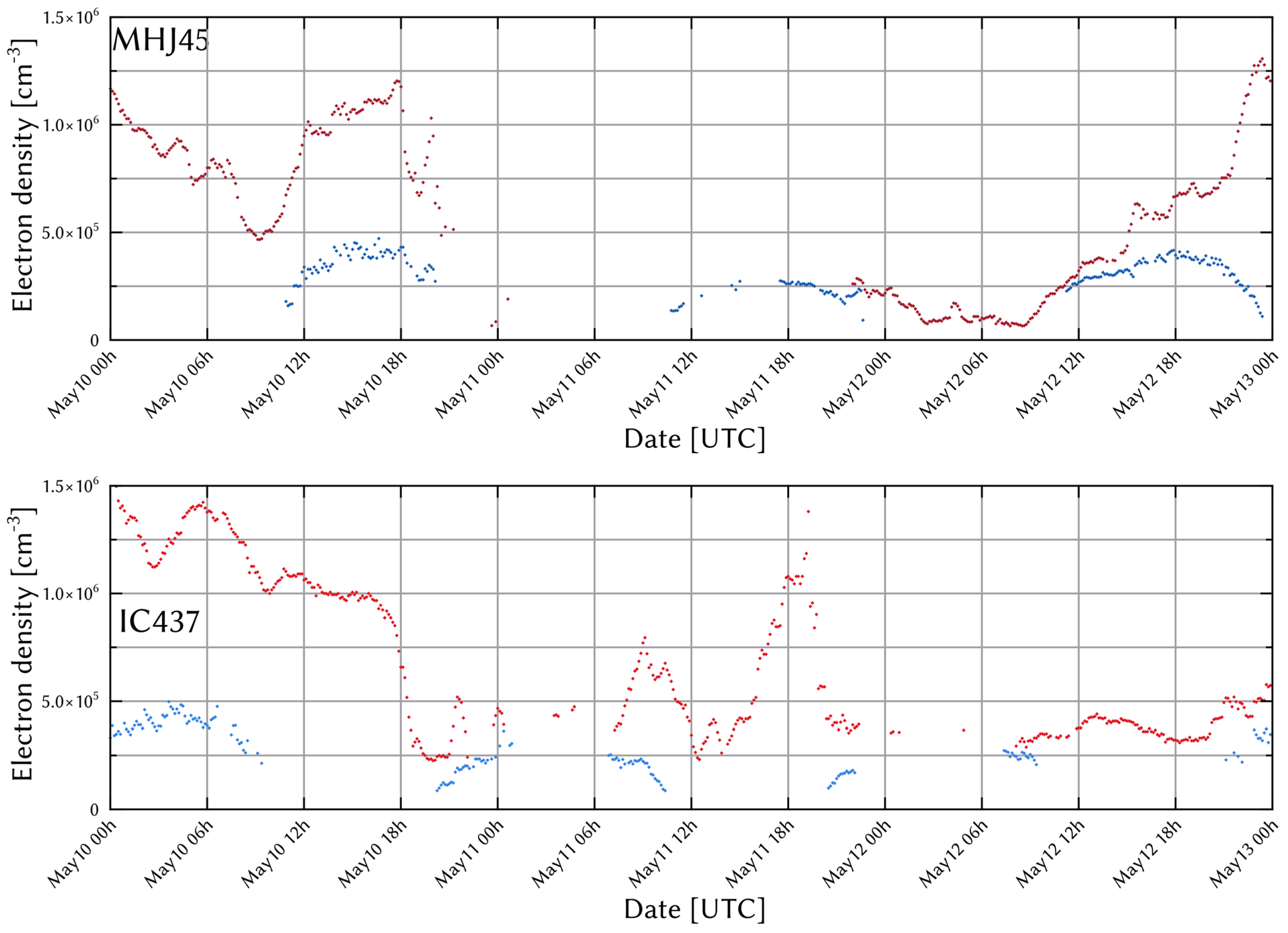
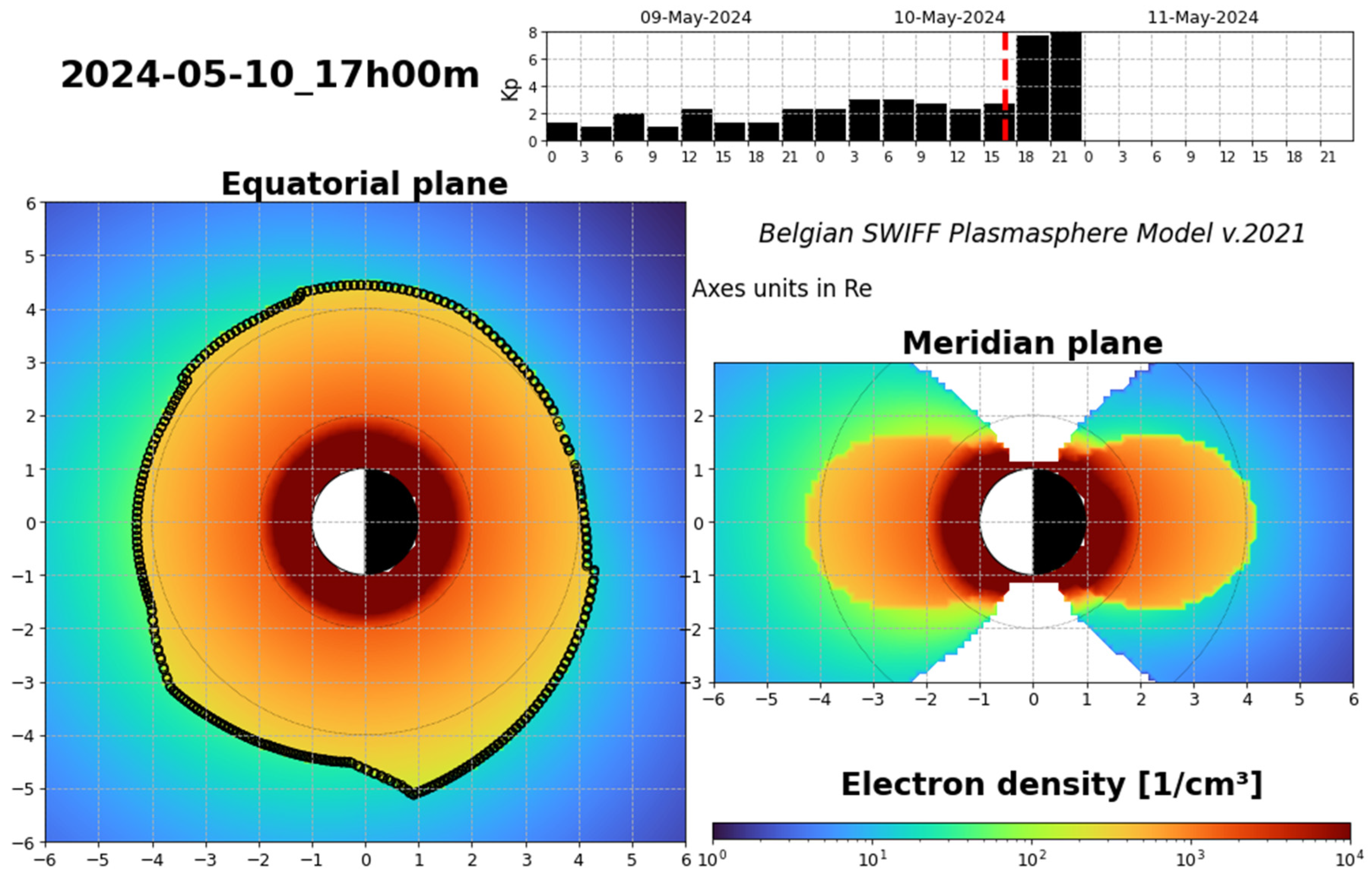
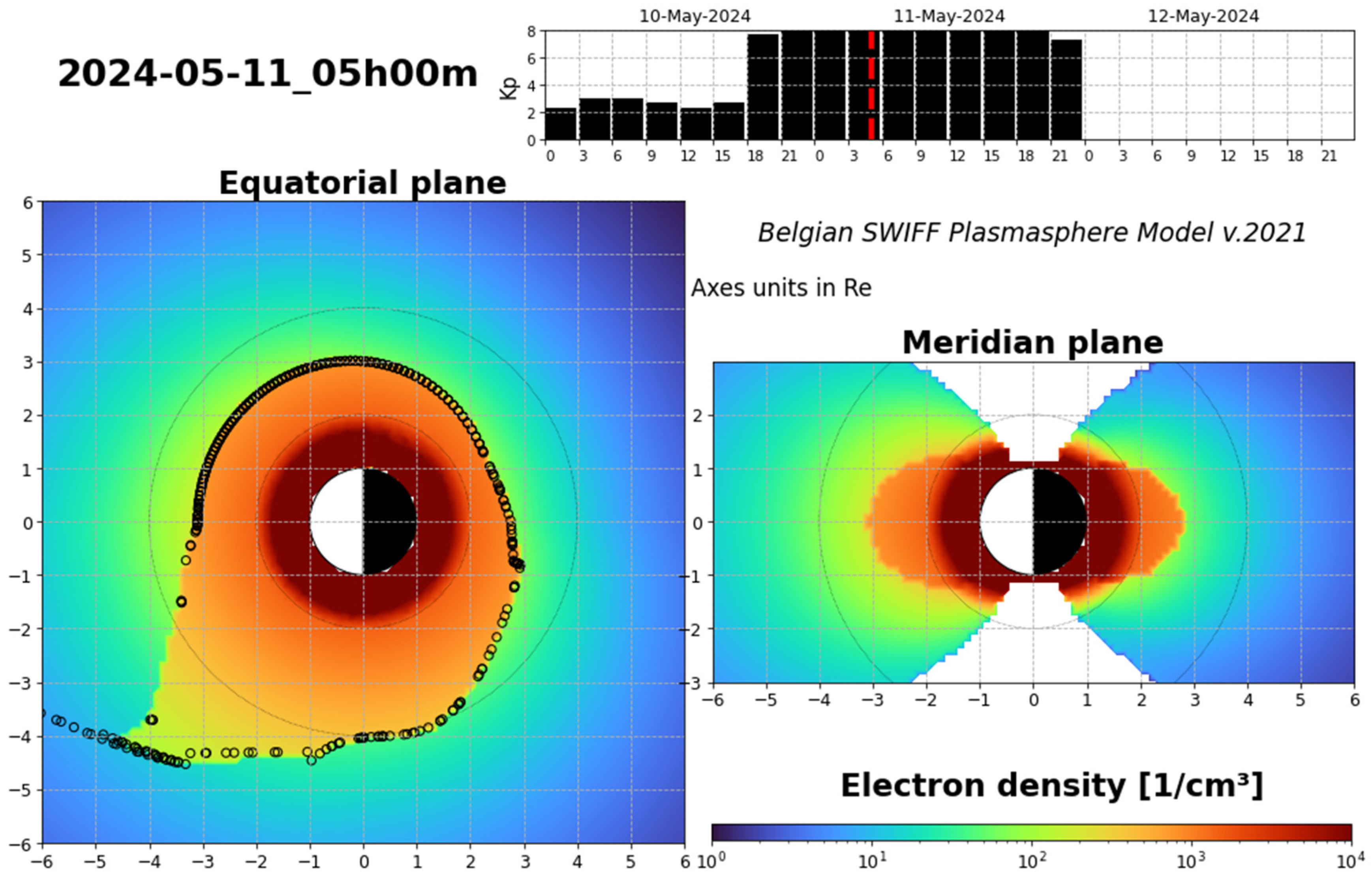
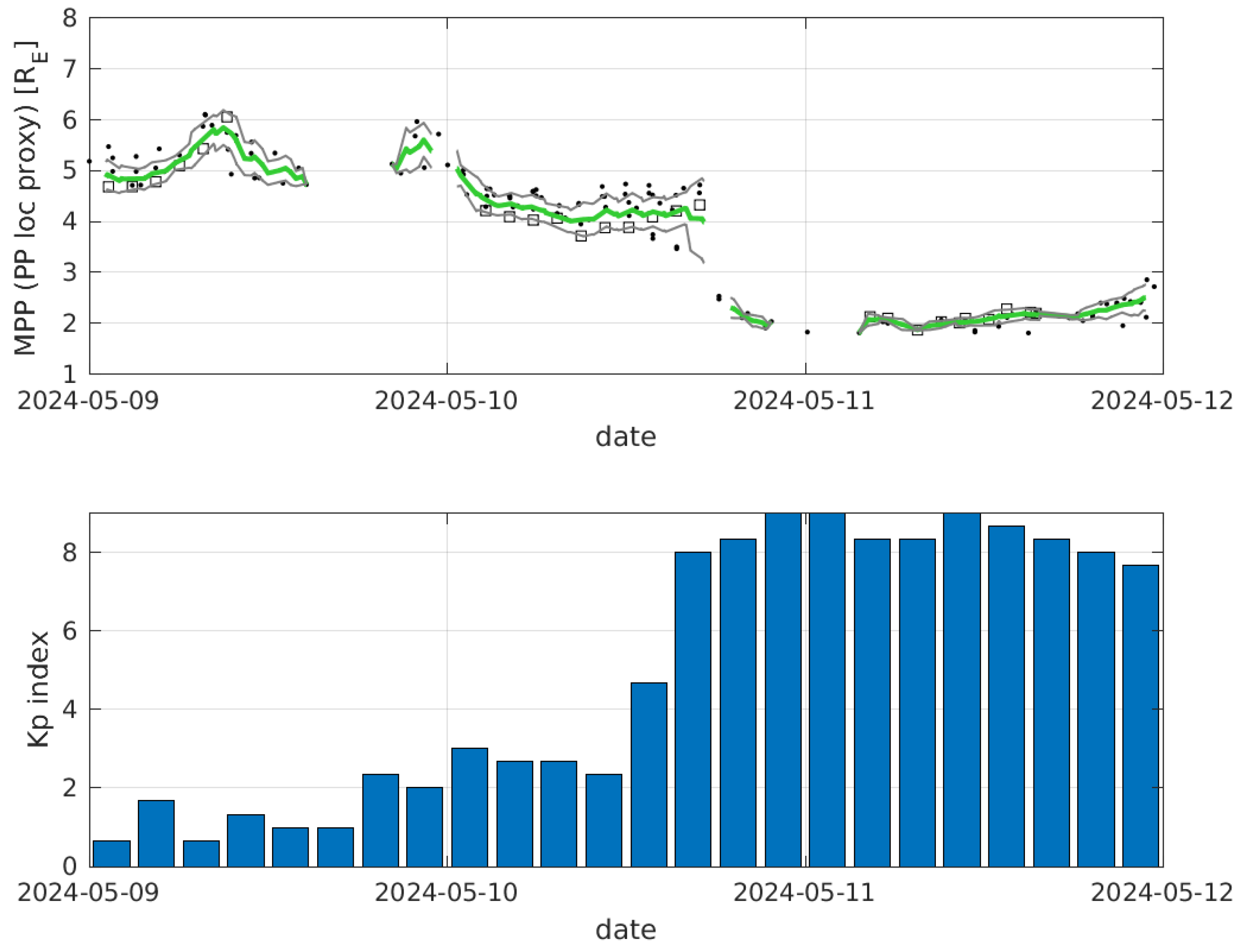
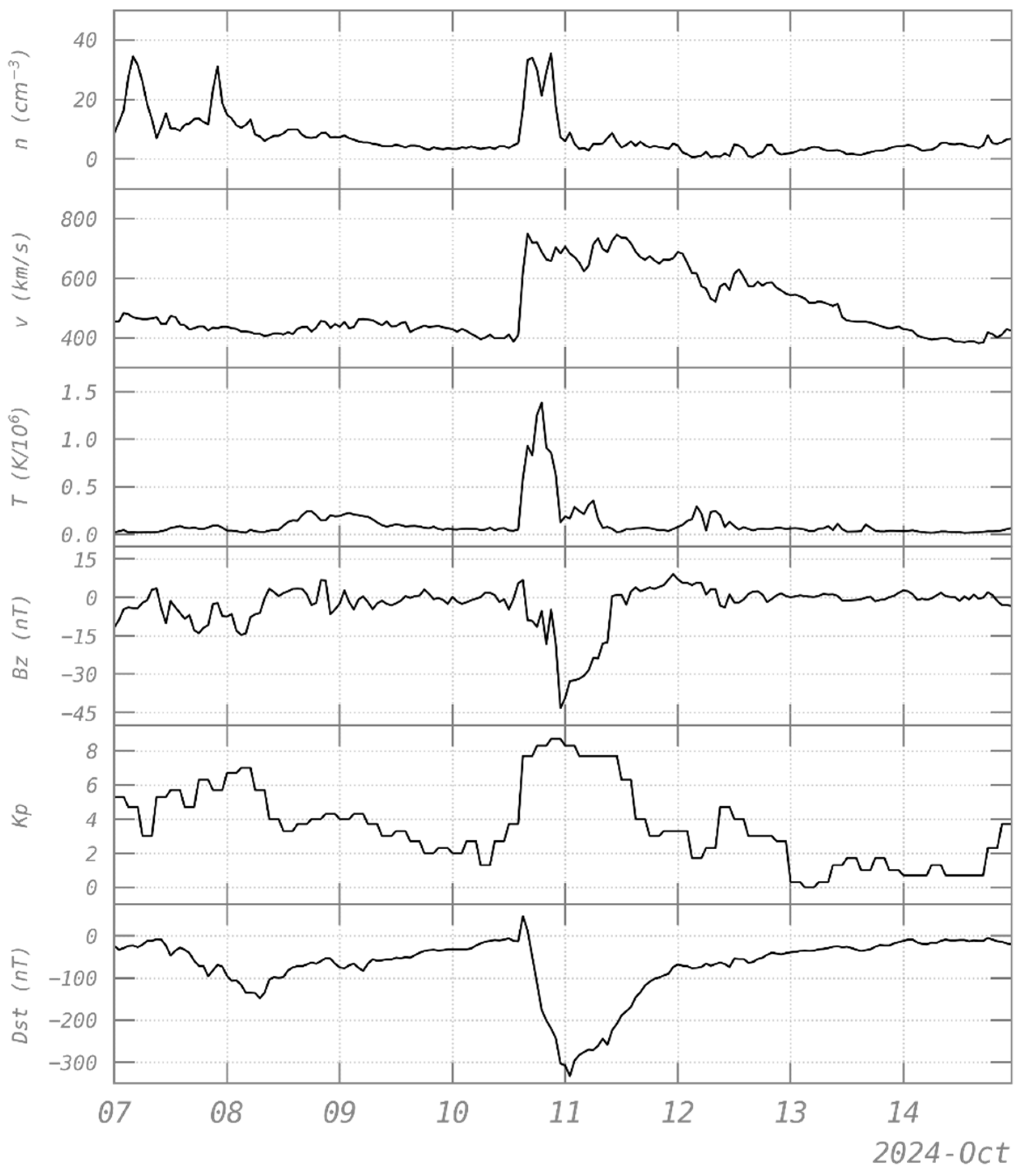
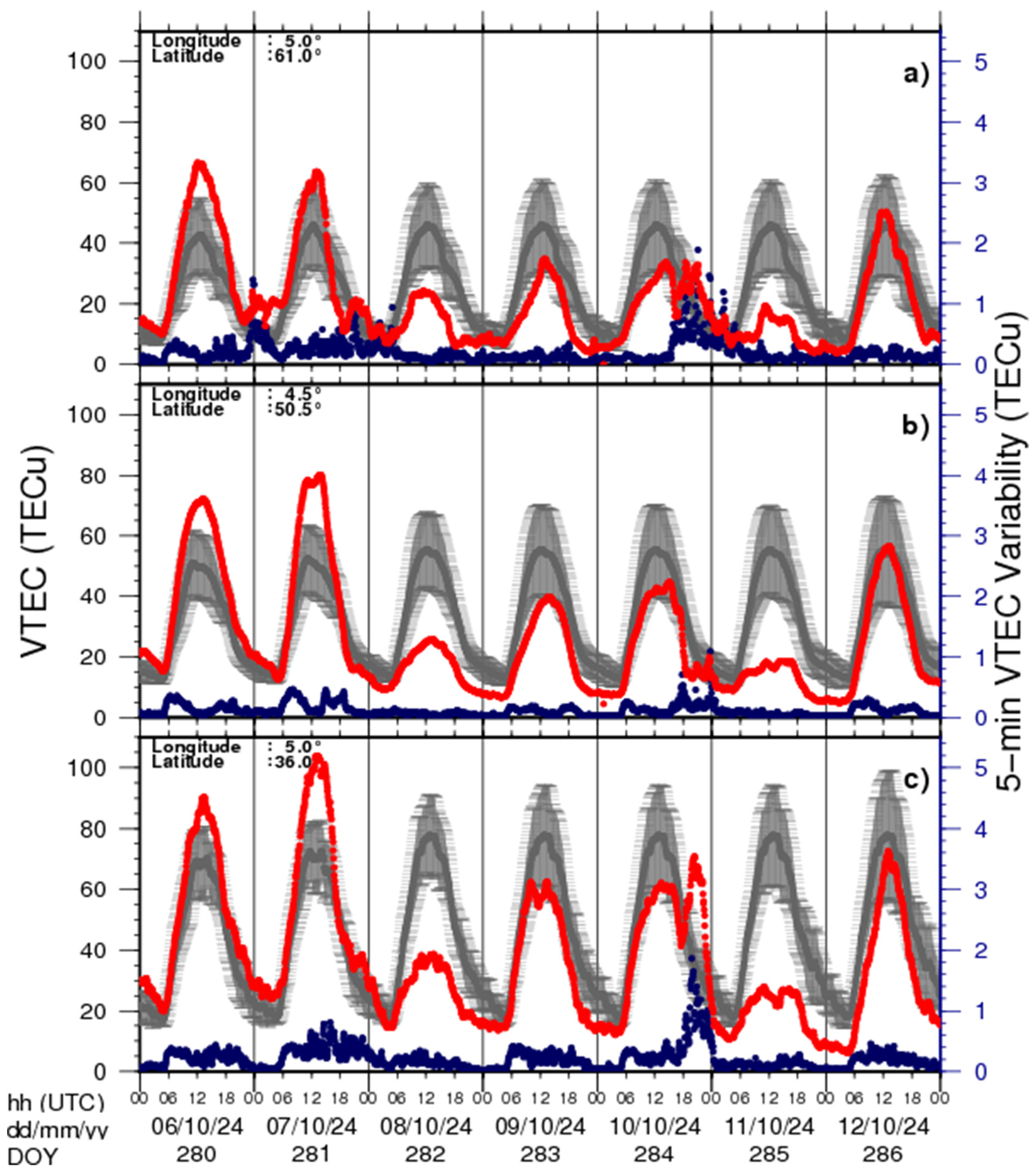
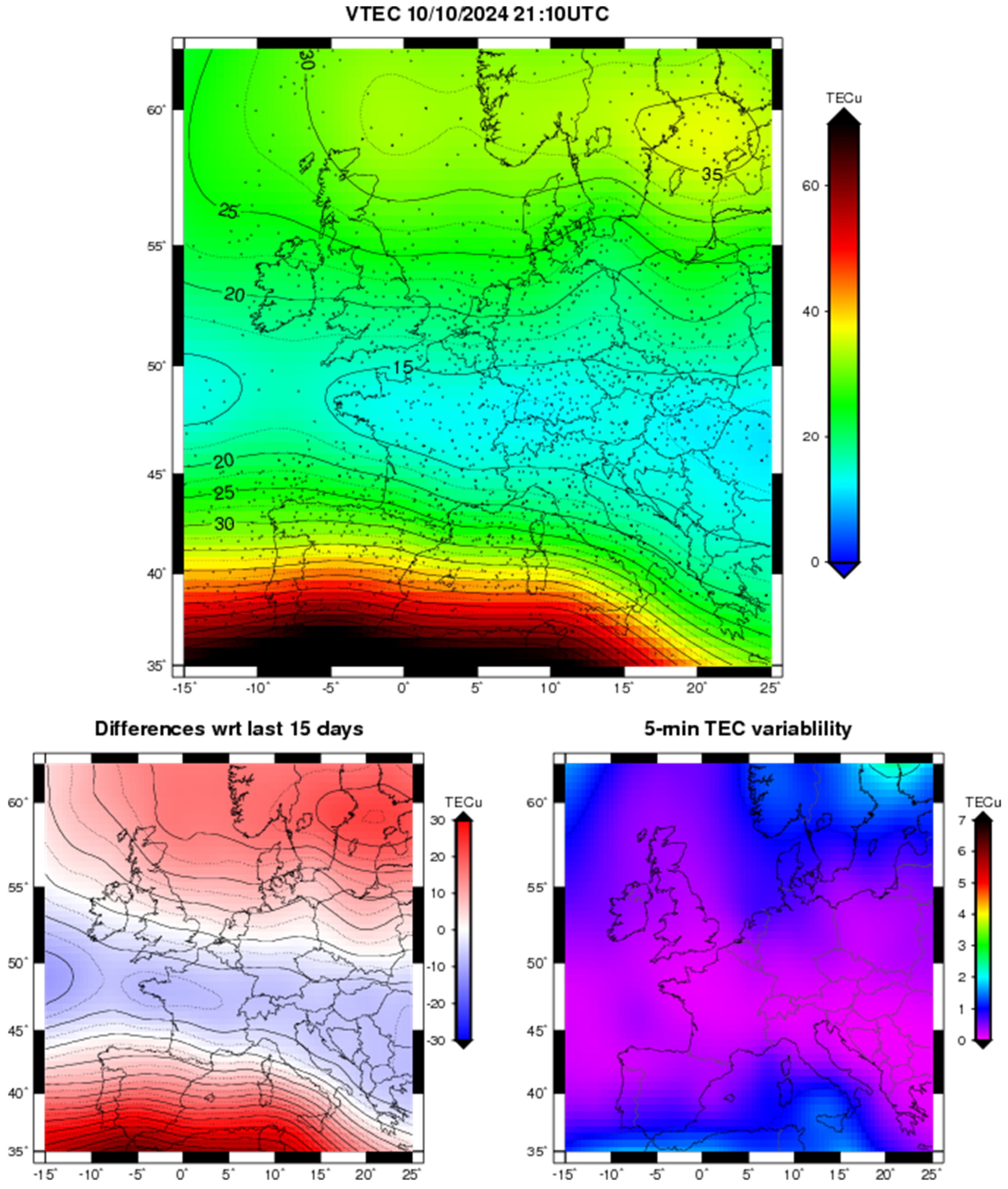
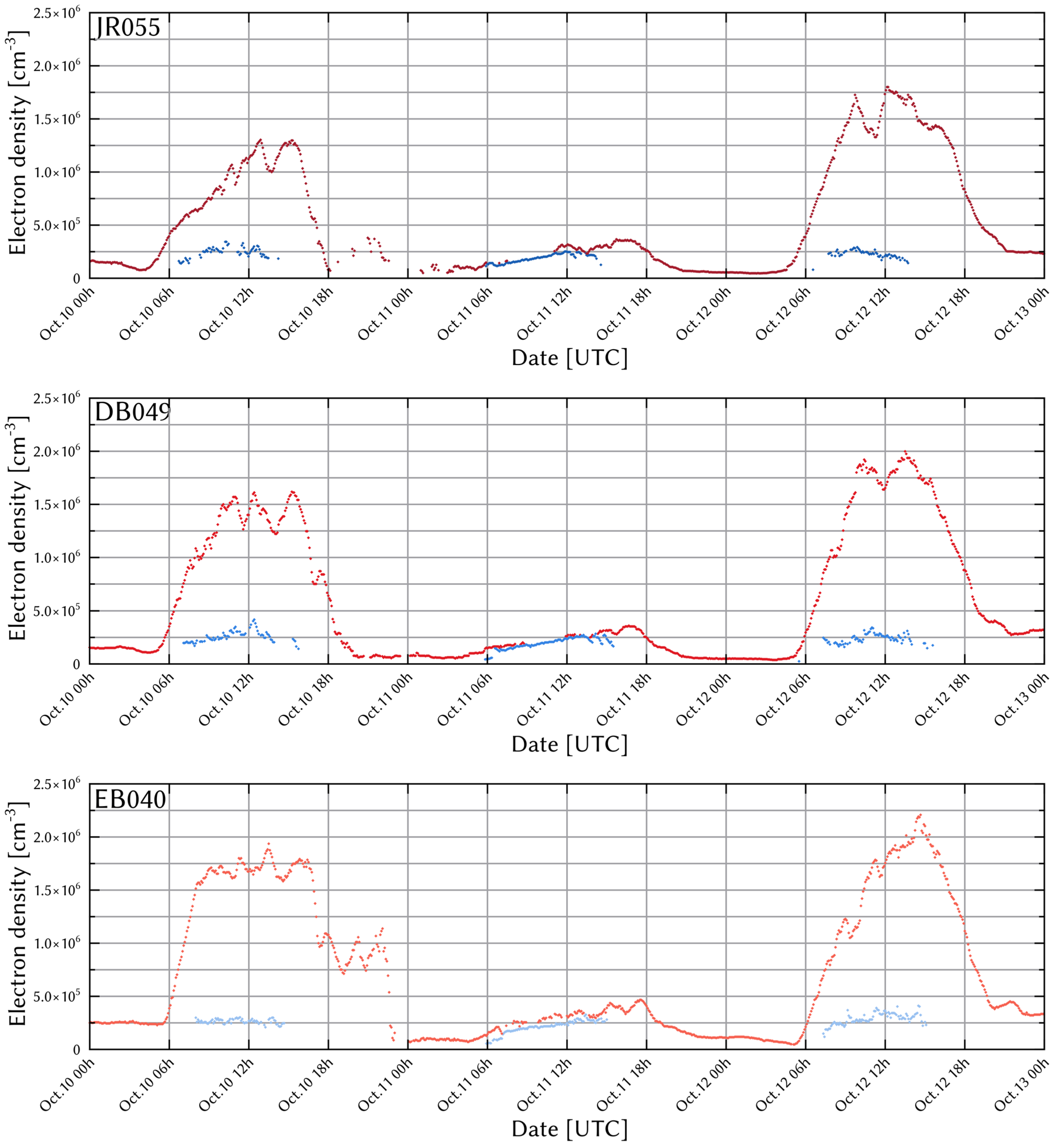
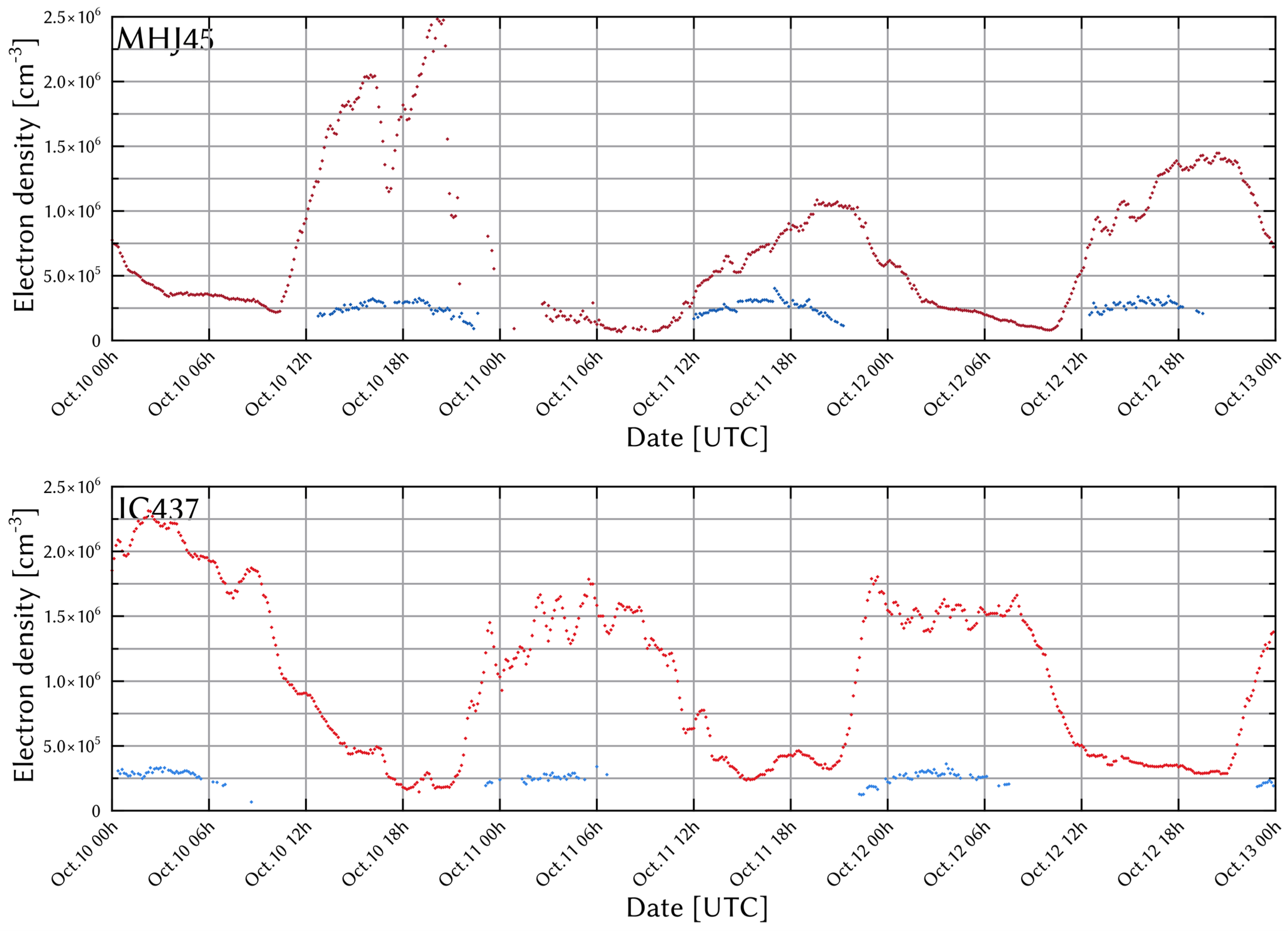
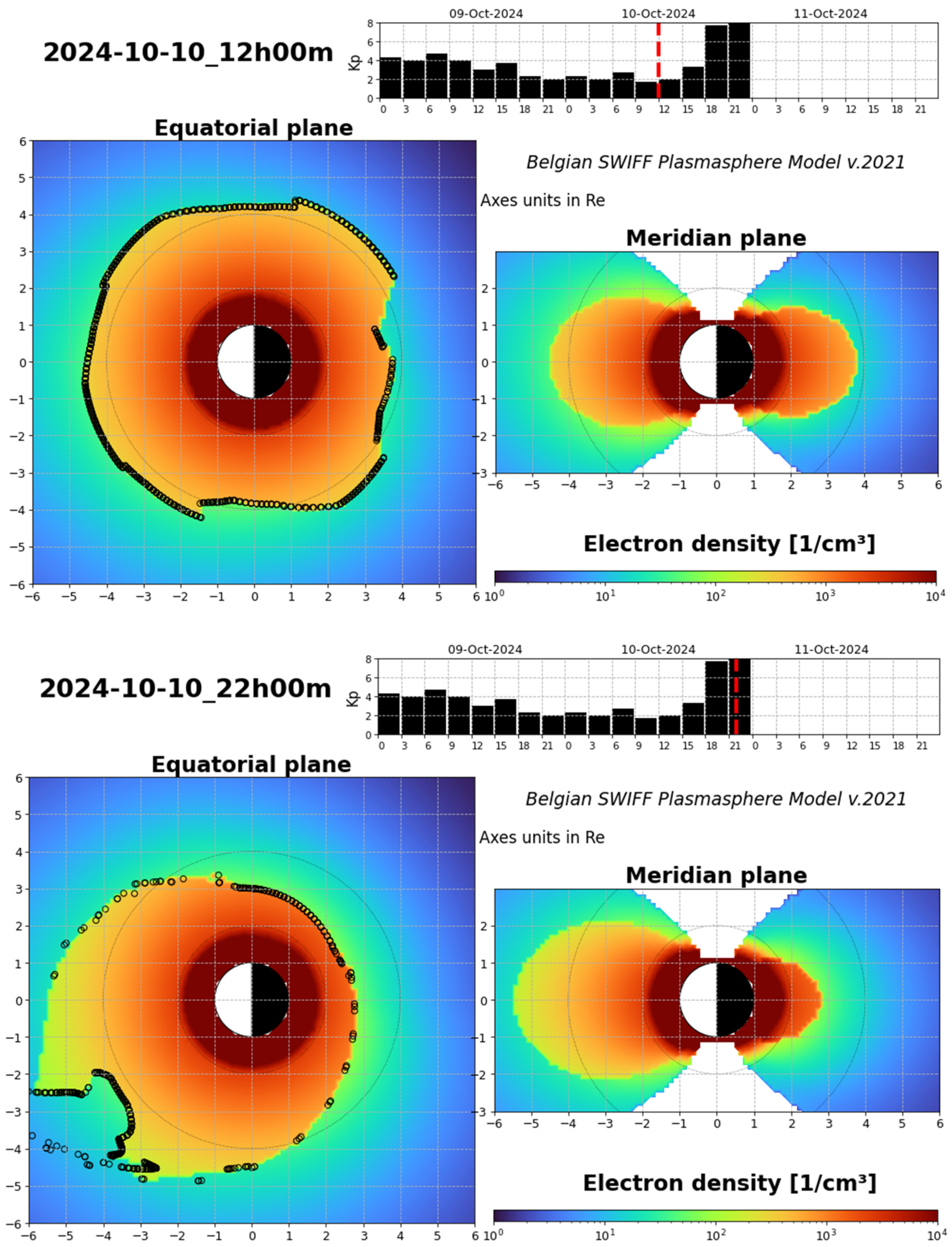
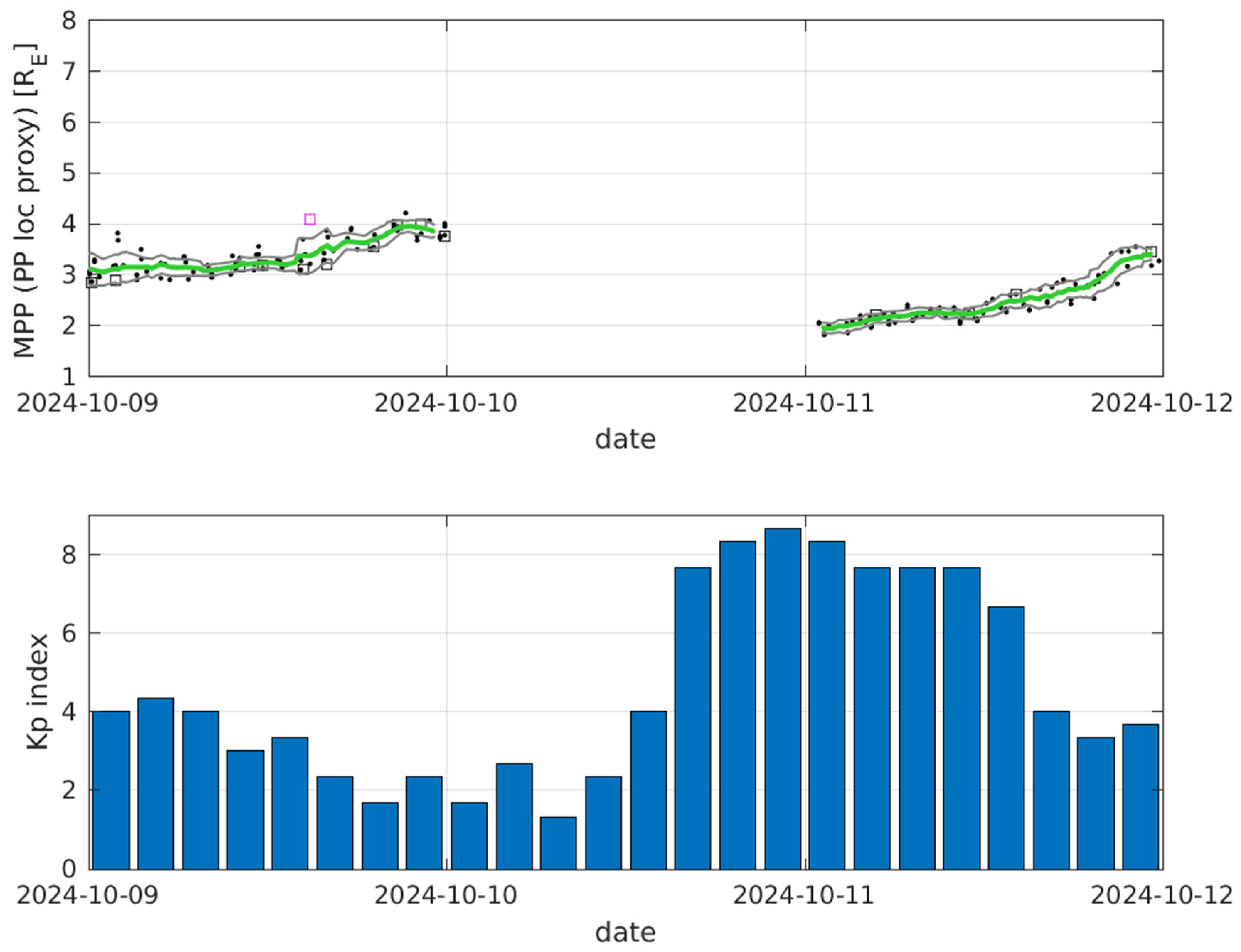
| Name (Country) | URSI Code | Latitude | Longitude |
|---|---|---|---|
| Juliusruh (Germany) | JR055 | 54.60° N | 13.40° E |
| Dourbes (Belgium) | DB049 | 50.10° N | 4.60° E |
| Roquetes (Spain) | EB040 | 40.80° N | 0.50° E |
| Millstone Hill (USA) | MHJ45 | 42.60° N | 288.50° E |
| I-Cheon (South Korea) | IC437 | 37.14° N | 127.54° E |
Disclaimer/Publisher’s Note: The statements, opinions and data contained in all publications are solely those of the individual author(s) and contributor(s) and not of MDPI and/or the editor(s). MDPI and/or the editor(s) disclaim responsibility for any injury to people or property resulting from any ideas, methods, instructions or products referred to in the content. |
© 2025 by the authors. Licensee MDPI, Basel, Switzerland. This article is an open access article distributed under the terms and conditions of the Creative Commons Attribution (CC BY) license (https://creativecommons.org/licenses/by/4.0/).
Share and Cite
Pierrard, V.; Verhulst, T.G.W.; Chevalier, J.-M.; Bergeot, N.; Winant, A. Effects of the Geomagnetic Superstorms of 10–11 May 2024 and 7–11 October 2024 on the Ionosphere and Plasmasphere. Atmosphere 2025, 16, 299. https://doi.org/10.3390/atmos16030299
Pierrard V, Verhulst TGW, Chevalier J-M, Bergeot N, Winant A. Effects of the Geomagnetic Superstorms of 10–11 May 2024 and 7–11 October 2024 on the Ionosphere and Plasmasphere. Atmosphere. 2025; 16(3):299. https://doi.org/10.3390/atmos16030299
Chicago/Turabian StylePierrard, Viviane, Tobias G. W. Verhulst, Jean-Marie Chevalier, Nicolas Bergeot, and Alexandre Winant. 2025. "Effects of the Geomagnetic Superstorms of 10–11 May 2024 and 7–11 October 2024 on the Ionosphere and Plasmasphere" Atmosphere 16, no. 3: 299. https://doi.org/10.3390/atmos16030299
APA StylePierrard, V., Verhulst, T. G. W., Chevalier, J.-M., Bergeot, N., & Winant, A. (2025). Effects of the Geomagnetic Superstorms of 10–11 May 2024 and 7–11 October 2024 on the Ionosphere and Plasmasphere. Atmosphere, 16(3), 299. https://doi.org/10.3390/atmos16030299






